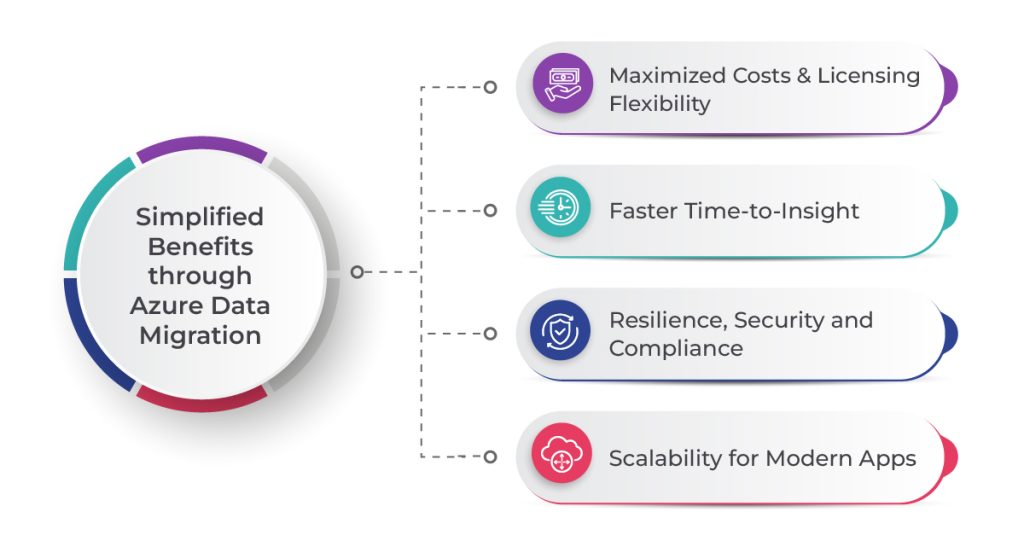For today’s enterprises, data is not only a fuel for operations, it’s a competitive differentiator. But if that data resides in legacy systems, on old hardware, or behind high licensable walls, it can turn into a liability in a snap. That is why database migration to Azure Cloud has become an integral part of digital transformation strategies across industries.
Let’s dive into the trends behind this movement, the business results at risk, and how to tackle Azure cloud migration with confidence and clarity.
The Trends: Why Migration to Azure Cloud Is Speeding Up
The fast track to cloud is no longer an issue of storage or elastics it’s the need to align IT strategy with business agility. Microsoft Azure, specifically, has established itself as a leader for database workloads because of its:
- Extensive integration with enterprise software such as Microsoft 365, Dynamics, and Power BI
- Powerful hybrid capabilities by way of services such as Azure Arc
- Extensive database support such as SQL Server, PostgreSQL, MySQL, and Cosmos DB
TierPoint states that migration to Azure Cloud is today the go-to choice for organizations looking for high availability, advanced analytics, and compliance-aware capabilities out of the box. Moreover, companies are increasingly giving top priority to cloud-native and PaaS-based databases such as Azure SQL Managed Instance in order to minimize overhead and enhance agility.
The Business Case: Simplified Benefits through Azure Data Migration
A successful Azure database migration is not only a technical improvement, it’s a transition that affects cost, productivity, and innovation.
1. Maximized Costs & Licensing Flexibility
Azure data migration enables businesses to right-size compute and storage, minimize licensing expense, and take advantage of pay-as-you-go pricing. Reserved instance pricing and auto-scaling provide long-term cost reductions. Saxon.ai observes numerous organizations achieving up to 40–50% cost savings after migration.
2. Faster Time-to-Insight
Integration with offerings such as Azure Synapse Analytics delivers real-time insights across data sources. Traditional systems just can’t respond to today’s business decision pace.
3. Resilience, Security & Compliance
From integrated disaster recovery to geo-redundant backup and advanced threat protection, Azure includes enterprise-level protection, supported by over 90 global compliance options.
4. Scalability for Modern Apps
Azure-hosted databases can scale app-independent, offering high performance to microservices, APIs, and cloud-native workloads. Along with Azure Kubernetes Services (AKS), companies can disintegrate monoliths into scalable, manageable services.

Strategic Roadmap: Best Practices for Azure Cloud Migration
At Aspire Systems, database migration to Azure Cloud is based on hands-on experience and strategic thoroughness. Here’s a phased approach based on both our established frameworks as well as top industry best practices:
1. Assessment & Cloud Readiness
- Evaluate legacy databases for migration to Azure Cloud feasibility
- Analyze Total Cost of Ownership (TCO) and performance indicators
- Select target database (e.g., Azure SQL, Cosmos DB, PostgreSQL)
- Map dependencies, data volume, and business-critical operations
2. Planning & Architecture
- Determine rehost, refactor, rearchitect, or rebuild
- Determine licensing model (BYOL or pay-as-you-go)
- Correlate security, compliance, availability, and scaling strategies
- Establish migration KPIs (downtime thresholds, success benchmarks)
3. Execution of Migration
- Use Azure Database Migration Service for schema conversion, data replication, and zero-downtime cutover
- Migrate low-risk workloads first (non-production environments)
- Use monitoring and rollback processes
- Validate performance and integrity of migrated databases
4. Optimization & Innovation
- Automate backup, patching, and scaling
- Integrate with DevOps pipelines for continuous delivery
- Monitor with Azure Monitor and Azure Advisor
- Re-engineer applications to take full advantage of Azure PaaS benefits
Aspire in Action: Value in the Real World
Aspire recently assisted a large enterprise migrate databases to Azure Cloud, moving mission-critical Oracle and SQL workloads to Azure SQL Managed Instance. The outcome?
- 38% reduction in query response times
- 40% decrease in total licensing expenditures
- 99.95% availability with active geo-replication
- 50% shorter analytics development cycles
Through Aspire’s combination of strategic consulting and Azure-native migration engineering, the customer transitioned from reactive maintenance to predictive, data-driven decision-making.
Final Thought: Migrate with Purpose, Perform with Confidence
Embracing Azure cloud migration isn’t merely about moving infrastructure. It’s about changing how your business manages data securely, efficiently, and at scale.
Whether you’re hosting legacy Oracle applications or wrestling with SQL Server performance, database migration to Azure Cloud provides a future-proof way forward. With Aspire Systems by your side, you receive more than an execution plan for your migration, you receive a roadmap for enduring cloud success.
Require expert advice on your Azure data migration process?
Let Aspire Systems assist you in evaluating, planning, and implementing with simplicity, so your data works harder for your business not the other way around.
- Why Azure Cloud Matters: Trends, Business Gains & Strategic Roadmap - August 7, 2025
- Transforming Businesses with Amazon Q Business and Amazon Q Adoption Catalyst - January 30, 2025
- Optimize Cloud Financial Management with FinOps Maturity - August 13, 2024

 Write to Us
Write to Us